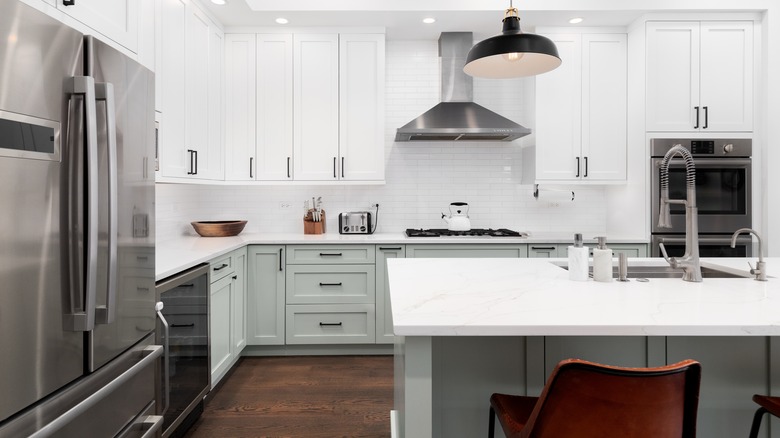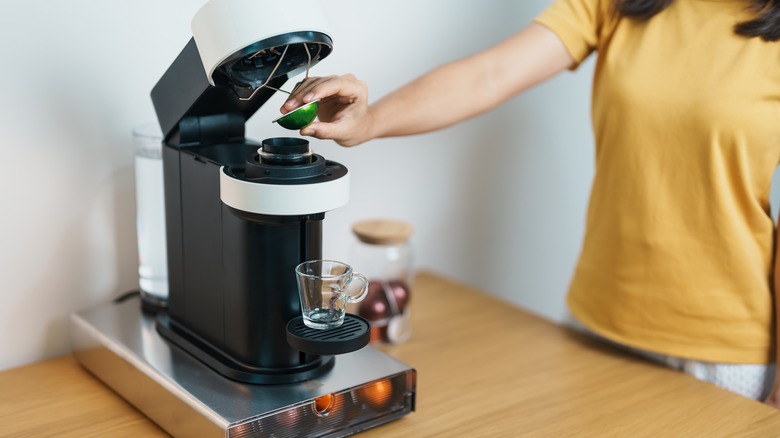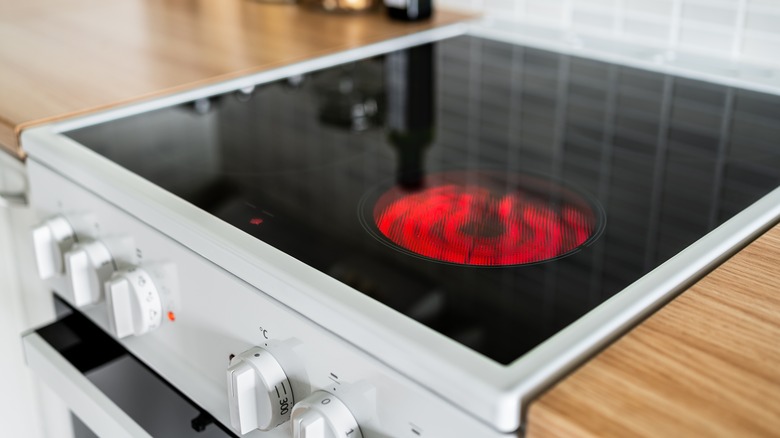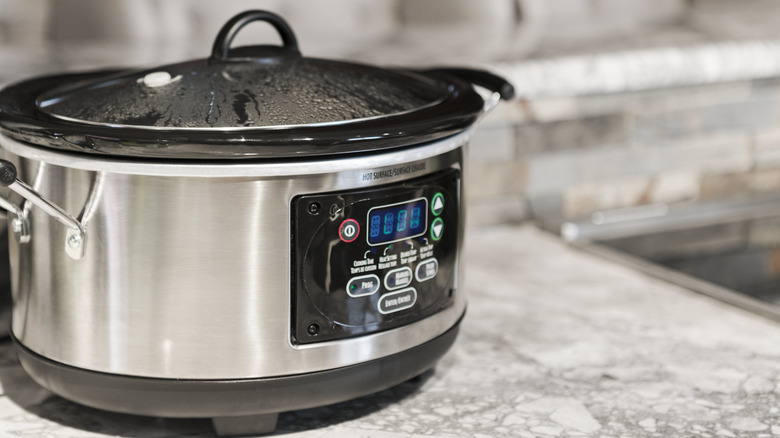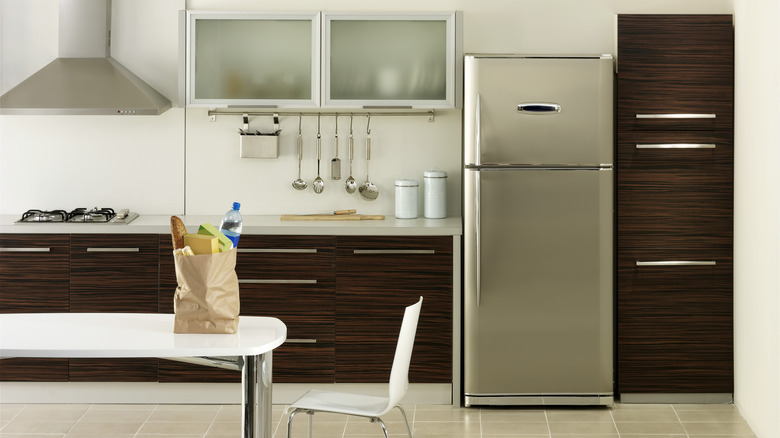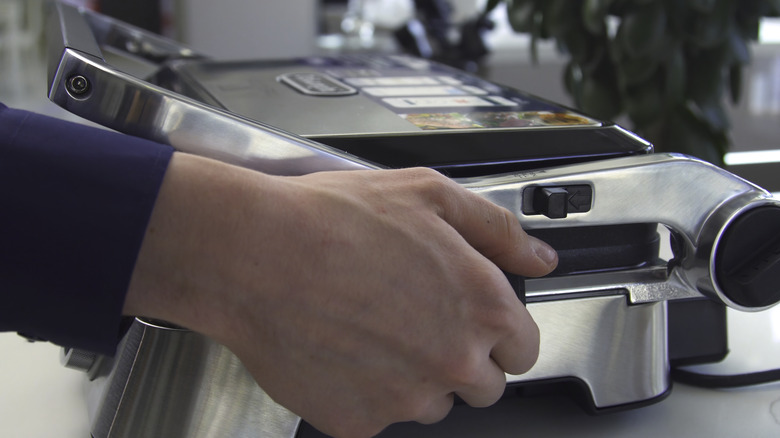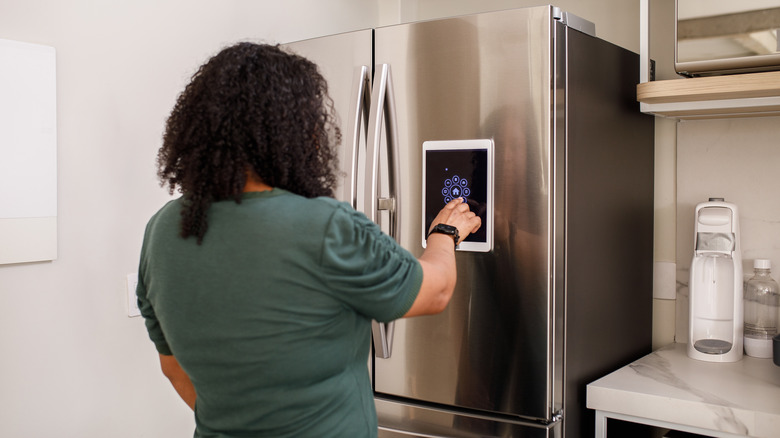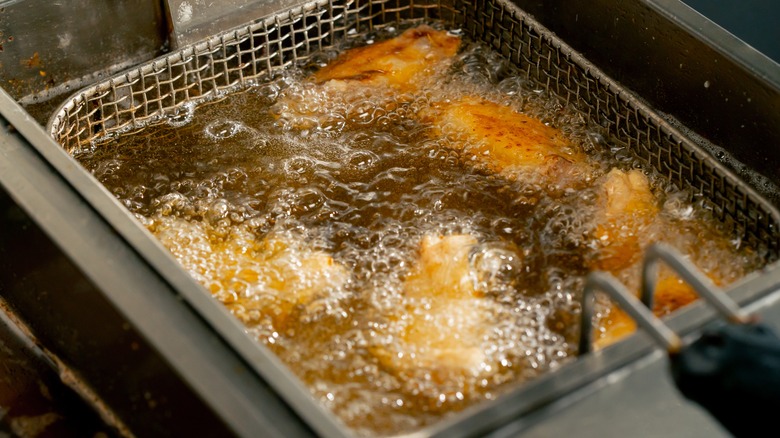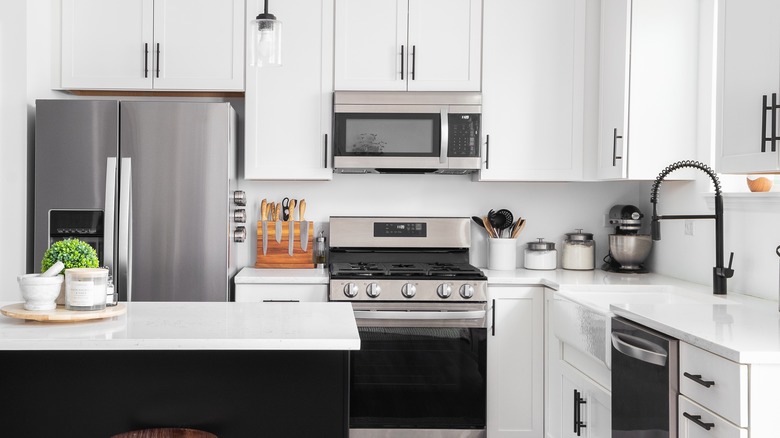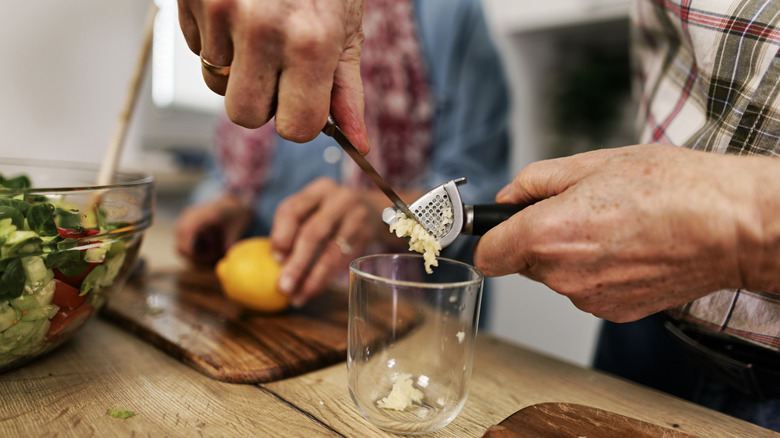10 Overrated Appliance Trends To Avoid Using In Your Kitchen
We may receive a commission on purchases made from links.
Ask 10 people what kitchen appliance trend they think is overrated, and there's a strong possibility you'll get 10 different answers. One person's most trusted kitchen appliance might be another person's biggest regret, long neglected, and taking up space in a hard-to-reach corner cabinet. Like most decisions you make for your home, the appliances you use in your kitchen should make sense to you. Just because your mom, best friend, or coworker swears by a certain appliance doesn't mean it's right for your kitchen.
Over time, though, it's hard to ignore some appliance trends that have arguably become overdone. These trends have become so dominant that it's hard to find a kitchen without them (we're looking at you, stainless steel). But, if they aren't your style or don't meet your needs, you should feel free to break with tradition and build the kitchen you want to have. For some inspiration, we're taking a look at 10 overrated appliance trends with alternative options you can consider instead.
Swap stainless steel for another appliance finish
Long a favorite for its durability and versatility, stainless steel may finally be on its way out — of the kitchen, anyway. While it offers a modern look and blends well with other kitchen fixtures, it has some downsides, too. It shows smudges, streaks, and fingerprints, and you need to avoid mistakes when cleaning stainless steel appliances. For example, you can't use abrasive cleaners or tools, which can scratch the finish. Aside from its high maintenance, stainless steel can also create a monotone, almost sterile, feel in the kitchen. Interior designer Satsha Lopez-Jaimes tells Business Insider it can make a kitchen feel uninviting. If you want your kitchen to be the heart of your home, it may be worth using other appliance finishes.
Fortunately, you have many options beyond stainless steel. When it's time to upgrade your big appliances, like the refrigerator or range, consider ones in a solid color, such as white or black. For a bold look, choose an unconventional hue, like green, blue, or pink. This range from Home Depot, for example, comes in turquoise or mint green, which can add a fun pop of color to your kitchen. And, don't feel like you have to stick to one finish, especially if you already have stainless steel in your kitchen. "Mix stainless steel appliances with other finishes like copper or custom paneling to create a balanced and visually appealing kitchen," Lopez-Jaimes says.
Single-serve coffee makers have many problems but few upsides
When you first wake up in the morning, tired and bleary-eyed, it's easy to pop a pod into your single-serve coffee maker and get the caffeine jolt you need. Single-serve coffee makers are quick and convenient, making them a popular choice for many kitchens. But the benefits of these coffee makers don't make up for all their downsides. Coffee aficionados criticize the stale, watery taste of coffee pods. It's difficult for manufacturers to keep the grounds fresh, and pods often don't contain enough coffee to produce a strong cup.
Plus, coffee pods create an incredible amount of waste that ends up in the landfill. While you can recycle Keurig K-Cup and Nespresso pods, it requires additional steps to do so responsibly, canceling out some of the convenience these pods offer in the first place. For some, it's enough to stop using K-Cups and other pods immediately.
If you want a fresh, flavorful cup of coffee without the waste, you have other options besides pods. A French press, like this one from Amazon, offers an easy, affordable way to make a single cup of coffee. A pour-over, which involves pouring hot water over coffee grounds, takes some more work but can produce excellent coffee. For simple, no-fuss coffee that rivals the convenience of pods, choose a drip coffee maker. Some drip machines, such as this one from Target, come with the option to brew a single cup or travel mug, rather than a full pot.
Electric or induction stovetop? The choice is clear
If you don't have a gas line in your kitchen, you're limited to an electric stovetop for your cooking needs. A common choice is an electric smoothtop range. It works by transferring heat to the cooking surface, which then heats your pots and pans. This conventional electric cooktop has some advantages, particularly in terms of cost-efficiency and convenience. It's compatible with most cookware, and you can usually find some budget-friendly options. However, there are some hidden downsides of electric stoves to consider as well. It can take a while to heat cookware, since the glass surface needs to get hot first. The burners also hold residual heat, so they take a few minutes to cool after you lower the temperature.
While you can get by with an electric smoothtop, you have another choice when gas isn't an option: an induction stovetop. An induction range looks similar to an electric smoothtop stove, but it functions differently. This type of stove has coils below the glass surface, which transmit pulses to the cookware — not the burners. For this reason, it heats your cookware faster, saving you some time in the kitchen. Consumer Reports found that induction ranges can boil water 20% to 40% faster than a conventional electric smoothtop. Plus, they're also 5% to 10% more energy-efficient than traditional electric stoves, according to the Department of Energy. They can be installed as stand alone cooktops or included as a feature on a range, like this one from Lowe's.
Slow cookers promise convenience but don't deliver
When you want a home-cooked meal without spending hours in the kitchen, a slow cooker seems to provide the obvious answer. You assemble a few ingredients, cover them with a lid, and set a timer. When it goes off some time later, you have a ready-to-serve meal with minimal cleanup. Sounds like a win, right? Well, maybe. Food writer Casey Barber shares with NBC's Today why the slow cooker may be the most overrated appliance in your kitchen. After experimenting with many recipes, Barber says her experience has led her to believe that slow-cooker meals not only take much longer to make. They also don't taste nearly as good as ones cooked with other methods. Plus, they promise convenience but add hidden steps to recipes, like needing to brown meat before transferring it to the crock.
So what can you use in place of your trusty slow cooker? According to cooking experts, it's easy to use a Dutch oven for low-and-slow cooking. A Dutch oven has some additional benefits over a slow cooker. It allows you to brown meat in the pan, giving you one less dish to wash. It's also versatile, providing the option of braising on the stove or in the oven. Barber says she favors a Dutch oven over a slow cooker, and she also uses a cast iron pan for some dishes. Don't forget about another slow cooker alternative you likely already have in your kitchen: the oven. Compared to a slow cooker, an oven can give you more flexibility.
Consider an alternative to the top- or bottom-freezer fridge
Walk into many kitchens in America, and you'll find a conventional refrigerator with one door for the fridge and a freezer door on the top or bottom. These fridge configurations, known as top- and bottom-freezer fridges, offer some pros, but they also have their cons. A top-freezer fridge, for example, usually doesn't come with a pull-out drawer, so you may find yourself digging in the back of the freezer for your ice cream. With a bottom-freezer fridge, you need to bend down to grab frozen items. Both configurations often lack helpful extras, like a water dispenser, or those features come at an increased cost.
Other configurations, such as side-by-side or French door fridges can offer increased versatility in your kitchen. In recent years, they've become an increasingly popular choice over the traditional top- or bottom-freezer fridge. You'll often get more refrigeration and freezer space with these configurations. This extra space can be a lifesaver for large families or budget-conscious shoppers who freeze certain foods, like meats. Multi-door fridges can also come with other perks, like built-in ice makers and temperature-controlled zones. Plus, the sleek, elegant design can make it look right at home in a modern kitchen.
Panini presses are a one-trick pony that need to go
If you love a melty, gooey sandwich (and who doesn't?), you may feel the need to purchase a panini press for your kitchen. A panini press is a small grill with heated plates that can produce a crisp, compressed sandwich. At first glance, it seems like a worthy addition to your kitchen, allowing you to skip the takeout and make your favorite sandwiches at home. But on closer inspection, the panini press isn't all it's cracked up to be. It's another appliance you have to find room to store in your kitchen, which can be tough if you have limited cupboard space. One cookbook author, Priya Krishna, tells Domino that it's easily the most overrated kitchen appliance. It's unnecessary and takes up valuable space in a kitchen, she says.
But can any other product give you the smashed sandwich you crave? According to Krishna, the answer is yes. She recommends using a second pan to press down on your favorite hot sandwich while you're frying it. Along those same lines, a spatula can also be used to press your sandwich down, allowing it to crisp more evenly. These techniques are certainly more cost-effective than buying a separate appliance that only does one thing. Per a roundup by U.S. News and World Report, the best panini presses start at around $100, and many cost much more than that. So, save your cash and put it toward a multifunctional kitchen appliance instead.
Smart appliances may not be worth the expense — yet
Like many other home appliances, kitchen devices have gotten more technologically advanced in recent years. These days, you can find Wi-Fi-enabled ovens and smart fridges with tablet displays. Smart appliances, as they're commonly known, generally include any devices that can connect to Wi-Fi or come powered by artificial intelligence (AI). These appliances offer convenience in a world that's become increasingly reliant on technology. They also hold the appeal of being new and innovative, promising a way to revolutionize the way you use your kitchen.
At the same time, the novelty of smart kitchen appliances also makes this trend one that you may want to wait on, at least for now. Jennifer Pattison Tuohy, a smart home reporter for The Verge, has been building a smart kitchen for several years. She shares that while tech-savvy appliances come with some benefits, they also have a way to go. Tuohy explains that the technology makes cooking more fun, but it comes with some challenges. In particular, that most appliances have their own apps that don't communicate with each other, creating a frustrating disconnect in a busy area of the home. The bottom line is that smart kitchen appliances are likely to get better as technology keeps advancing, so don't feel the need to rush out and replace all your appliances immediately. Your "dumb" oven should continue to do just fine for now.
Ditch the deep fryer for a less problematic device
When you want fresh French fries or perfectly battered chicken, you might break out the deep fryer to do the job. Many people use these to make crunchy vegetables, crispy chicken wings, golden-fried pastries, and everything in between. However, deep fryers have problems that go beyond the health risks of consuming too much fried food. Most notably, they're a significant contributor of cooking emissions, which account for nearly 40% of particulate pollution in some cities, according to one study covered by The University of Birmingham. Since deep fryers use hot oil, those emissions can spread more widely, decreasing the air quality further. Beyond their negative environmental impacts, they are bulky and take up considerable space on a kitchen counter or inside a cupboard.
Unless you fry food regularly, it's hard to justify keeping a deep fryer in your kitchen. As an alternative, consider an air fryer instead, such as this one from Walmart. Unlike a deep fryer, an air fryer works by quickly circulating hot air to heat food. This can't replicate deep-fried foods entirely, but it can produce the crisp, crunchy textures you crave. Plus, it's a healthier alternative, since it uses little to no oil for cooking. If you still want to enjoy deep-fried foods from time to time, you can use other tools you may already have in your kitchen, like a Dutch oven.
Visible appliances are out, and hidden devices are in
In a kitchen, there's often a competing contrast between function and style. Whether due to limited cupboard space or sheer necessity, many appliances, like your coffee maker and toaster, have traditionally been on full display. Some appliances, like the range and stove, have nowhere else to go. You may have just accepted that your appliances need to be visible, whether they look nice with rest of your decor or not.
Luckily for you, that's not necessarily the case anymore. Hiding appliances has become popular the last few years with the invisible kitchen being the next big trend. Interior designer Audrey Scheck goes so far as to say visible appliances may be on their way out. "Appliances are certainly necessary in a kitchen, however, concealing them is becoming even more popular," Scheck tells Forbes. "We're seeing a rise in panel-ready appliances, which allow for a custom panel to be installed on top of a refrigerator or dishwasher to seamlessly integrate them into kitchen cabinetry."
While custom panels provide a solution for large appliances, there are other clever ways to hide your small appliances for a clutter-free kitchen. An appliance garage has a small door you can open and close to keep your appliances hidden. Or, you can dedicate an area of your pantry to store these gadgets.
Single-use gadgets are rarely worth the hype
Wander through the kitchen section of any home store, and you'll find dozens of single-use gadgets designed to simplify the cooking process. These include a variety of items, like potato peelers, lemon zesters, avocado slicers, strawberry hullers, pineapple corers, and more. Sure, many work exactly as intended. But buy enough of them, an you'll have an overflowing drawer of items that each do only one thing. Even Ina Garten considers one single-use gadget to be the most overrated kitchen tool: a garlic press. "I never use a garlic press; I always have a knife handy and it does the same thing perfectly well," Garten says on her website. "The fewer fancy gadgets you have, the more organized your kitchen will be."
Take a cue from the cooking expert and simplify your kitchen by getting rid of these single-use appliances. Look for other ways you can accomplish the same tasks without cluttering your drawers. In many cases, you can use items you already have in your kitchen, like knives, shears, and other utensils. You can also swap the single-use tools for multifunctional items, like a food processor or a mandoline slicer. You'll have more room in your kitchen, and you won't need to spend money every time you come across a new gadget for slicing or dicing.

